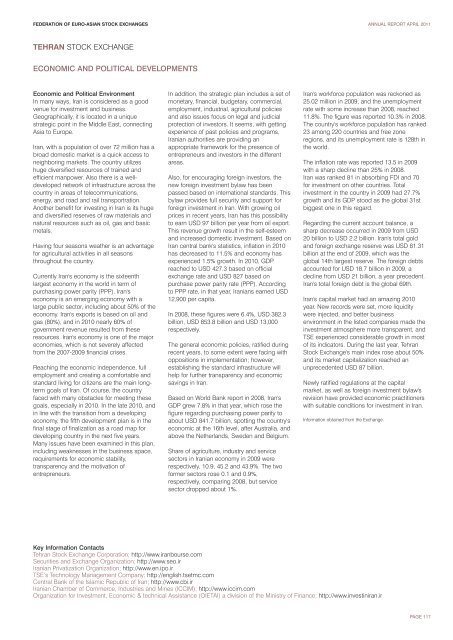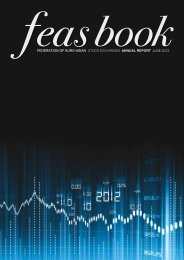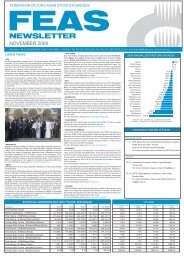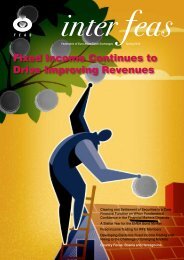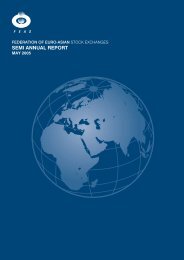Download - FEAS
Download - FEAS
Download - FEAS
Create successful ePaper yourself
Turn your PDF publications into a flip-book with our unique Google optimized e-Paper software.
FEDERATION OF EURO-ASIAN STOCK EXCHANGES ANNUAL REPORT APRIL 2011<br />
TEHRAN STOCK EXCHANGE<br />
ECONOMIC AND POLITICAL DEVELOPMENTS<br />
Economic and Political Environment<br />
In many ways, Iran is considered as a good<br />
venue for investment and business.<br />
Geographically, it is located in a unique<br />
strategic point in the Middle East, connecting<br />
Asia to Europe.<br />
Iran, with a population of over 72 million has a<br />
broad domestic market is a quick access to<br />
neighboring markets. The country utilizes<br />
huge diversified resources of trained and<br />
efficient manpower. Also there is a welldeveloped<br />
network of infrastructure across the<br />
country in areas of telecommunications,<br />
energy, and road and rail transportration.<br />
Another benefit for investing in Iran is its huge<br />
and diversified reserves of raw materials and<br />
natural resources such as oil, gas and basic<br />
metals.<br />
Having four seasons weather is an advantage<br />
for agricultural activities in all seasons<br />
throughout the country.<br />
Currently Iran's economy is the sixteenth<br />
largest economy in the world in term of<br />
purchasing power parity (PPP). Iran's<br />
economy is an emerging economy with a<br />
large public sector, including about 50% of the<br />
economy. Iran's exports is based on oil and<br />
gas (80%), and in 2010 nearly 60% of<br />
government revenue resulted from these<br />
resources. Iran's economy is one of the major<br />
economies, which is not severely affected<br />
from the 2007-2009 financial crises.<br />
Reaching the economic independence, full<br />
employment and creating a comfortable and<br />
standard living for citizens are the main longterm<br />
goals of Iran. Of course, the country<br />
faced with many obstacles for meeting these<br />
goals, especially in 2010. In the late 2010, and<br />
in line with the transition from a developing<br />
economy, the fifth development plan is in the<br />
final stage of finalization as a road map for<br />
developing country in the next five years.<br />
Many issues have been examined in this plan,<br />
including weaknesses in the business space,<br />
requirements for economic stability,<br />
transparency and the motivation of<br />
entrepreneurs.<br />
In addition, the strategic plan includes a set of<br />
monetary, financial, budgetary, commercial,<br />
employment, industrial, agricultural policies<br />
and also issues focus on legal and judicial<br />
protection of investors. It seems, with getting<br />
experience of past policies and programs,<br />
Iranian authorities are providing an<br />
appropriate framework for the presence of<br />
entrepreneurs and investors in the different<br />
areas.<br />
Also, for encouraging foreign investors, the<br />
new foreign investment bylaw has been<br />
passed based on international standards. This<br />
bylaw provides full security and support for<br />
foreign investment in Iran. With growing oil<br />
prices in recent years, Iran has this possibility<br />
to earn USD 97 billion per year from oil export.<br />
This revenue growth result in the self-esteem<br />
and increased domestic investment. Based on<br />
Iran central bank's statistics, inflation in 2010<br />
has decreased to 11.5% and economy has<br />
experienced 1.5% growth. In 2010, GDP<br />
reached to USD 427.3 based on official<br />
exchange rate and USD 827 based on<br />
purchase power parity rate (PPP). According<br />
to PPP rate, in that year, Iranians earned USD<br />
12,900 per capita.<br />
In 2008, these figures were 6.4%, USD 382.3<br />
billion, USD 853.8 billion and USD 13,000<br />
respectively.<br />
The general economic policies, ratified during<br />
recent years, to some extent were facing with<br />
oppositions in implementation; however,<br />
establishing the standard infrastructure will<br />
help for further transparency and economic<br />
savings in Iran.<br />
Based on World Bank report in 2008, Iran's<br />
GDP grew 7.8% in that year, which rose the<br />
figure regarding purchasing power parity to<br />
about USD 841.7 billion, spotting the country's<br />
economic at the 16th level, after Australia, and<br />
above the Netherlands, Sweden and Belgium.<br />
Share of agriculture, industry and service<br />
sectors in Iranian economy in 2009 were<br />
respectively, 10.9, 45.2 and 43.9%. The two<br />
former sectors rose 0.1 and 0.9%,<br />
respectively, comparing 2008, but service<br />
sector dropped about 1%.<br />
Iran's workforce population was reckoned as<br />
25.02 million in 2009, and the unemployment<br />
rate with some increase than 2008, reached<br />
11.8%. The figure was reported 10.3% in 2008.<br />
The country's workforce population has ranked<br />
23 among 220 countries and free zone<br />
regions, and its unemployment rate is 128th in<br />
the world.<br />
The inflation rate was reported 13.5 in 2009<br />
with a sharp decline than 25% in 2008.<br />
Iran was ranked 81 in absorbing FDI and 70<br />
for investment on other countries. Total<br />
investment in the country in 2009 had 27.7%<br />
growth and its GDP stood as the global 31st<br />
biggest one in this regard.<br />
Regarding the current account balance, a<br />
sharp decrease occurred in 2009 from USD<br />
20 billion to USD 2.2 billion. Iran's total gold<br />
and foreign exchange reserve was USD 81.31<br />
billion at the end of 2009, which was the<br />
global 14th largest reserve. The foreign debts<br />
accounted for USD 18.7 billion in 2009, a<br />
decline from USD 21 billion, a year precedent.<br />
Iran's total foreign debt is the global 69th.<br />
Iran's capital market had an amazing 2010<br />
year. New records were set, more liquidity<br />
were injected, and better business<br />
environment in the listed companies made the<br />
investment atmosphere more transparent, and<br />
TSE experienced considerable growth in most<br />
of its indicators. During the last year, Tehran<br />
Stock Exchange's main index rose about 50%<br />
and its market capitalization reached an<br />
unprecedented USD 87 billion.<br />
Newly ratified regulations at the capital<br />
market, as well as foreign investment bylaw's<br />
revision have provided economic practitioners<br />
with suitable conditions for investment in Iran.<br />
Information obtained from the Exchange.<br />
Key Information Contacts<br />
Tehran Stock Exchange Corporation; http://www.iranbourse.com<br />
Securities and Exchange Organization; http://www.seo.ir<br />
Iranian Privatization Organization; http://www.en.ipo.ir<br />
TSE’s Technology Management Company; http://english.tsetmc.com<br />
Central Bank of the Islamic Republic of Iran; http://www.cbi.ir<br />
Iranian Chamber of Commerce, Industries and Mines (ICCIM); http://www.iccim.com<br />
Organization for Investment, Economic & technical Assistance (OIETAI) a division of the Ministry of Finance; http://www.investiniran.ir<br />
PAGE 117


